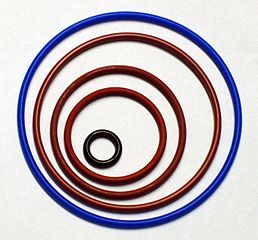Viton vs Nitrile O Rings
Oct 31, 2018
 As two of the most commonly used elastomers, both Viton™ and nitrile o rings have some fantastic properties. Both offer excellent compression set and have a wide range of uses in industrial and domestic applications. However, not everything is equal between these two popular materials, and it’s important to know which is better for particular applications. Here, we’ll look at Viton™ vs nitrile o rings to see where each should be used, and why.
As two of the most commonly used elastomers, both Viton™ and nitrile o rings have some fantastic properties. Both offer excellent compression set and have a wide range of uses in industrial and domestic applications. However, not everything is equal between these two popular materials, and it’s important to know which is better for particular applications. Here, we’ll look at Viton™ vs nitrile o rings to see where each should be used, and why.
Nitrile o-rings
Also called NBR or Buna-N, nitrile o rings are probably the most economical and widely used elastomer out there. This material has a desirable set of properties including low compression set, high resistance to abrasion and good tensile strength.
- Temperature range: Effective from -40°C to 120°C
- Suitability: General purpose, particularly in areas where the seal will be exposed to hydrocarbons, oils, petrol, water and hydraulic fluids
- Benefits: Excellent abrasion and tear resistance, cost effective
- Limitations: Nitrile is not good at resisting degradation by ozone or weather
You’ll find nitrile o rings used in many applications, including where oil resistance is needed or where low temperature functionality is required. These include automotive, aircraft fuel systems, marine applications and more.
Viton™ o rings
The name Viton is a trademark, a bit like Hoover or Sellotape, and refers to fluorocarbon o rings, or FKM/FPM for short. This material has an excellent tolerance for high temperatures, resistance to oils, fuels and hydraulic fluids as well as aromatics and solvents.
Various types of FKM/FPM/Viton™ o rings are available, with varying amounts of fluorine additions which increase performance in specific situations.
- Temperature range: From -40°C up to 250°C
- Suitability: Good for use in high temperature situations or where chemicals are being used. As well as resisting oils, petrol and hydrocarbons, Viton™ is resistant to mineral acids, halogenated hydrocarbons and more.
- Benefits: Resistant to the majority of chemicals, as well as to degradation by UV, weather, ozone and mould.
- Limitations: Less tolerant of low temperatures
You’ll find FKM/FPM o rings in a huge variety of applications from aircraft engines to vehicle components, particularly where resistance to corrosive liquids and fuels is required. This material has low compression set characteristics, making it ideal for use in high temperature environments, as well as resistance to all sorts of chemicals.
Viton™ vs nitrile o rings – which is the right choice?
Viewing these two o ring materials at a glance, it’s easy to see some occasions where the decision of Viton™ vs nitrile o rings will be clear to see. For example, if you know your assembly works at more than 100°C, nitrile will not be suitable. If your assembly is likely to be exposed to the weather, to UV or to ozone, nitrile will likely degrade and risk failure.
Viton™ /FKM/FPM is superior to nitrile in almost all situations, excluding operation at sub zero temperatures.
If you’re not sure which you need in the case of Viton™ vs nitrile o rings, we’re here to help. We’ve worked alongside customers from all sorts of diverse industries to help match them up with the right o ring for their needs and can help you too. We want to make sure you get all the functionality you need, without spending more than is necessary. Talk to our experienced team today for advice and support.
